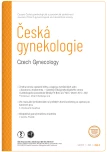Včasné zahájení embryotransferů po transplantaci dělohy v zájmu zkrácení podávání imunosupresivní léčby
Autoři:
Roman Chmel 1
; Marta Nováčková 1
; M. Čekal 1
; J. Matěcha 2
; Zlatko Pastor 1
Působiště autorů:
Department of Obstetrics and Gynecology, Second Faculty of Medicine, Charles University and Motol University Hospital, Prague
1; Department of Obstetrics and Gynecology, First Faculty of Medicine, Charles University and Hospital Bulovka, Prague
2
Vyšlo v časopise:
Ceska Gynekol 2022; 87(5): 346-349
Kategorie:
Přehledový článek
doi:
https://doi.org/10.48095/cccg2022346
Souhrn
Transplantace dělohy představuje nadějnou metodu kauzální léčby absolutního uterinního faktoru neplodnosti u žen s chybějící či reprodukčně nefunkční dělohou. Léčba sterility pomocí transplantace dělohy je stále v experimentální fázi a pravidla provádění jednotlivých kroků této složité metody nejsou dosud jednoznačně stanovena. Potenciální příjemkyně dělohy podstupuje před transplantací stimulaci ovarií a oplodnění cestou in vitro fertilizace. Takto získaná embrya se kryoprezervují a uskladňují. Transfer jednoho embrya se provádí v odstupu po transplantaci, kdy příjemkyně dělohy užívá pouze nefetotoxická imunosupresiva. V první studii transplantace dělohy ve Švédsku se embryotransfery začaly provádět v odstupu 12 měsíců od transplantace. Vzhledem k rostoucím zkušenostem zejména s časnými rejekcemi po transplantaci dělohy a průběhy těhotenství byl v několika probíhajících studiích experimentálně zkrácen interval mezi transplantací a prvním embryotransferem na 6 měsíců. Hlavním důvodem včasného zahájení embryotransferů po transplantaci dělohy je zkrácení celkové doby podávání imunosuprese. Bezpečnost kratšího než ročního intervalu mezi transplantací dělohy a prvním embryotransferem po transplantaci by však měla být dále studována.
Klíčová slova:
in vitro fertilizace – transplantace dělohy – embryotransfer – absolutní uterinní faktor neplodnosti
Zdroje
1. Brännström M, Dahm-Kähler P, Kvarnström N et al. Reproductive, obstetric, and long-term health outcome after uterus transplantation: results of the first clinical trial. Fertil Steril 2022; 118 (3): 576–585. doi: 10.1016/j.fertnstert. 2022.05.017.
2. Johannesson L, Kvarnström N, Mölne J et al. Uterus transplantation trial: 1-year outcome. Fertil Steril 2015; 103 (1): 199–204. doi: 10.1016/ j.fertnstert.2014.09.024.
3. Lefkowitz A, Edwards M, Balayla J. Ethical considerations in the era of the uterine transplant: an update of the Montreal criteria for the ethical feasibility of uterine transplantation. Fertil Steril 2013; 100 (4): 924–926. doi: 10.1016/j.fertnstert.2013.05.026.
4. Chmel R jr, Pastor Z, Mužík M et al. Syndrome Mayer-Rokitansky-Küster-Hauser – uterine and vaginal agenesis: current knowledge and therapeutic options. Ceska Gynekol 2019; 84 (5): 386–392.
5. Chmel R jr, Nováčková M, Chubanovová N et al. Sexuality in women with Mayer-Rokitansky--Küster-Hauser syndrome. Ceska Gynekol 2021; 86 (3): 194–199. doi: 10.48095/cccg2021194.
6. Chmel R, Cekal M, Pastor Z et al. Assisted reproductive techniques and pregnancy results in women with Mayer-Rokitansky-Küster-Hauser syndrome undergoing uterus transplantation: the Czech experience. J Pediatr Adolesc Gynecol 2020; 33 (4): 410–414. doi: 10.1016/ j.jpag.2020.03.006.
7. Johannesson L, Wall A, Putman JM et al. Rethinking the time interval to embryo transfer after uterus transplantation – DUETS (Dallas UtErus Transplant Study). BJOG 2019; 126 (11): 1305–1309. doi: 10.1111/1471-0528.15860.
8. Brännström M, Johannesson L, Bokström H et al. Livebirth after uterus transplantation. Lancet 2015; 385 (9968): 607–616. doi: 10.1016/S0140 - 6736 (14) 61728-1.
9. Testa G, McKenna GJ, Gunby RT Jr et al. First live birth after uterus transplantation in the United States. Am J Transplant 2018; 18 (5): 1270–1274. doi: 10.1111/ajt.14737.
10. Ejzenberg D, Andraus W, Baratelli Carelli Mendes LR et al. Livebirth after uterus transplantation from a deceased donor in a recipient with uterine infertility. Lancet 2019; 392 (10165): 2697–2704. doi: 10.1016/S0140-6736 (18) 31766-5.
11. Flyckt R, Falcone T, Quintini C et al. First birth from a deceased donor uterus in the United States: from severe graft rejection to successful cesarean delivery. Am J Obstet Gynecol 2020; 223 (2): 143–151. doi: 10.1016/ j.ajog.2020.03.001.
12. Brännström M, Dahm-Kähler P, Kvarnström N et al. Live birth after robotic-assisted live donor uterus transplantation. Acta Obstet Gynecol Scand 2020; 99 (9): 1222–1229. doi: 10.1111/aogs.13853.
13. Mölne J, Broecker V, Ekberg J et al. Monitoring of human uterus transplantation with cervical biopsies: a provisional scoring system for rejection. Am J Transplant 2017; 17 (6): 1628–1636. doi: 10.1111/ajt.14135.
14. Chmel R, Novackova M, Pastor Z. Lessons learned from the Czech uterus transplant trial related to surgical technique that may affect reproductive success. Aust N Z J Obstet Gynaecol 2020; 60 (4): 625–627. doi: 10.1111/ajo.13 184.
15. Chmel R, Pastor Z, Matecha J et al. Uterine transplantation in an era of successful childbirths from living and deceased donor uteri: current challenges. Biomed Pap Med Fac Univ Palacky Olomouc Czech Repub 2020; 164 (1): 115–120. doi: 10.5507/bp.2019.020.
16. McKay DB, Josephson MA. Pregnancy in recipients of solid organs – effect on mother and child. N Engl Med 2006; 354 (12): 1281–1293. doi: 10.1056/NEJMra050431.
Štítky
Dětská gynekologie Gynekologie a porodnictví Reprodukční medicínaČlánek vyšel v časopise
Česká gynekologie

2022 Číslo 5
Nejčtenější v tomto čísle
- Distální vaginální ageneze a diferenciální diagnostika dalších příčin hematokolpos
- Idiopatická granulomatózna mastitída
- Vliv manuální lymfodrenáže na lymfedém horní končetiny po operaci pro karcinom prsu
- Psoriáza vulvy
